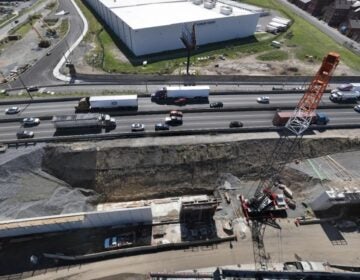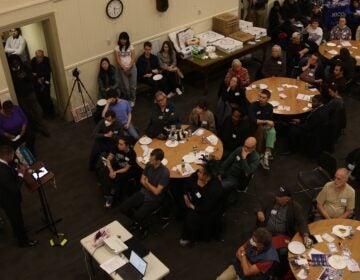Market-Frankford El fallout

Aug. 21
By Anthony Campisi
For PlanPhilly
Though SEPTA is finishing up its reconstruction of the Market-Frankford El, the message from community leaders Thursday night was that much work remains to help West Philadelphia neighborhoods affected by 10 years of construction.
Community members impacted by the El reconstruction heard from city officials and SEPTA about plans to rebuild areas that faced severe economic disruption during construction, which involved the closing of Market Street to traffic while train stations and train tracks in West Philadelphia were rebuilt.
Though Frances Jones, SEPTA’s assistant general manager of government affairs, said that the authority planned no further projects along Market Street, she said that SEPTA had spent about $745 million in the community in the form of the much-needed El reconstruction and improvements to the streetscape under the train tracks.
“We are leaving West Philadelphia,” she said, adding that she would “stake my life on” an economic renaissance in the area over the next two or three years as businesses cluster around new stations.
“There will be no” vacancies, Jones said, arguing that, though some businesses did close as a result of the problems caused by construction, others were planning on moving to the area.
The crowd, composed of residents, business leaders and neighborhood association leaders, was not so sure, however.
Ruth Bazemore, a West Philadelphia resident who helped organize the meeting, held at the Sanctuary Church of the Open door at 59th and Walnut streets, complained that “we saw very little of input, economically, that impacted our own people” in terms of the employment of West Philadelphia residents and contractors in the construction process.
Though SEPTA is not planning any further projects — it’s finishing up a $5 million project to replace the sidewalks and curbs under the El — other city agencies tried explaining the city planning effort to revitalize the Market Street corridor.
The Planning Commission is completing studies that will form the basis for rezoning part of the corridor to stimulate transit-oriented development around the new stations, according to Andrew Meloney of the commission’s Community Planning Division.
The end goal is to bring high-density, mixed-use development to the areas around the stations and to fill in gaps between stations with medium-density development. The Planning Commission is also planning on converting several vacant parcels into parks and plazas and is drawing up plans for pedestrian-friendly lighting and new signage for the area.
The commission says that kind of development will better-connect commercial corridors on Chestnut and Walnut streets to train stations on Market Street, Meloney said.
Darin Gatti of the Streets Department also described a $10 million project to repave and beautify Market Street.
The money, which will be available next year from the Pennsylvania Department of Transportation, will be used to plant trees along Market Street, as well as to install new stoplights that are designed to ease traffic congestion. The lights give preferential signaling to buses and emergency vehicles along Market Street and will also be programmed to change signal times depending on the time of day to better-handle commuting patterns.
Gatti said that the department was also planning on building pedestrian bump-outs at intersections.
At the same time, officials sought to reassure community members who remain deeply suspicious of the city’s plans for the area.
A disconnect between the city’s development plans and the community’s knowledge of those plans and trust in the planning process was evident.
Meloney had to reassure residents and business leaders several times that no businesses or residents would be forced out as a result of the rezoning process, and a representative of the Sanitation Department heard from the Rev. Essie Boatwright, who also helped plan the meeting, about the trash collection problems under the El.
Though trash collection occurs three times a week under the tracks, businesses and residents dump their trash in empty lots and under the train tracks. At the same time, Boatwright complained that the department was failing to find the perpetrators of the dumping and was instead ticketing residents like her who were trying to clean up the mess.
Andy Toy, director of the Retail Resource Network of the Enterprise Center, which tries to foster minority entrepreneurship, also talked about problems in disbursing grant money to businesses affected by the construction project.
Though each of the 229 businesses affected by the closure was supposed to receive a grant of about $5,000 from PennDOT for business development, only 35 merchants have been paid so far, he said, adding that the Philadelphia Commercial Development Corporation, which was not present at the meeting, was responsible for disbursing the money.
The Enterprise Center has interviewed 80 merchants to find out what they plan on doing with the money, a requirement to receiving the grants, according to Toy.
At the same time, Toy did point to the Enterprise Center’s work in helping merchants develop marketing strategies and in educating business owners about their customer base.
The meeting was also punctuated by a confrontation between Bazemore and Blackwell, who, before leaving the meeting, criticized the organizers for fighting battles that had already been fought.
She argued that it was too late to fight for increased minority and local hiring for the construction project, which is almost done.
“All of these things are over,” she said, adding that residents who were serious about addressing quality-of-life issues should work through her office.
“I love you,” Blackwell said.
However, after Blackwell left, Bazemore asked the residents who remained whether they had heard about a meeting Blackwell said she was attending next month to fight a $500 fee on businesses the Nutter administration is hoping to assess for trash pickup.
When the crowd shook their heads no, Bazemore, who had called the meeting because of a perceived lack of communication between the city and the neighborhood, said, “I rest my case.”
Contact the reporter at campisi.anthony@gmail.com
WHYY is your source for fact-based, in-depth journalism and information. As a nonprofit organization, we rely on financial support from readers like you. Please give today.






